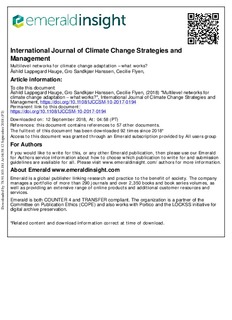| dc.contributor.author | Hauge, Åshild Lappegard | |
| dc.contributor.author | Hanssen, Gro Sandkjær | |
| dc.contributor.author | Flyen, Cecilie | |
| dc.date.accessioned | 2018-09-27T11:26:56Z | |
| dc.date.available | 2018-09-27T11:26:56Z | |
| dc.date.created | 2018-09-12T14:03:59Z | |
| dc.date.issued | 2018 | |
| dc.identifier.issn | 1756-8692 | |
| dc.identifier.uri | http://hdl.handle.net/11250/2564982 | |
| dc.description.abstract | Purpose
The paper aims to compare and evaluate two Norwegian municipal networks for climate change adaptation, to see how such networks should be initiated and implemented as a means of achieving adaptation measures within municipalities.
Design/methodology/approach
The findings are based on 12 qualitative interviews taken from two case studies, and the results are explained in relation to the multilevel network framework and environmental psychology.
Findings
Multilevel networks can promote learning and identification of specific actions in connection with climate change adaptation. The aim should be to establish interdisciplinarity, with participants from at least two authority levels. Representatives should be in positions that enable them to introduce acquired knowledge to the organization and influence its application. A network requires organizational commitment, during the initial phase and throughout the follow-up process. Municipal leaders (mayors) must be aware of the network, act as signatories to relevant documents, and be familiar with participating representatives. Commitment to knowledge application within the organization also requires that participants understand where and how to work strategically to convert new ideas into action.
Practical implications
This paper presents practical and research-based guidelines for the management of climate change adaptation networks at municipal, county and national authority levels.
Originality/value
This paper combines political science and environmental psychology perspectives as a means of analysing network achievements. A psychological approach may help to promote a greater understanding of why and how network knowledge is transferred. | nb_NO |
| dc.language.iso | eng | nb_NO |
| dc.publisher | Emerald | nb_NO |
| dc.rights | Navngivelse 4.0 Internasjonal | * |
| dc.rights.uri | http://creativecommons.org/licenses/by/4.0/deed.no | * |
| dc.title | Multilevel networks for climate change adaptation – what works? | nb_NO |
| dc.type | Journal article | nb_NO |
| dc.type | Peer reviewed | nb_NO |
| dc.description.version | publishedVersion | nb_NO |
| dc.source.journal | International Journal of Climate Change Strategies and Management | nb_NO |
| dc.identifier.doi | 10.1108/IJCCSM-10-2017-0194 | |
| dc.identifier.cristin | 1608906 | |
| dc.relation.project | Norges forskningsråd: 237859 | nb_NO |
| dc.description.localcode | © Åshild Lappegard Hauge, Gro Sandkjær Hanssen and Cecilie Flyen 2018. Published by Emerald Publishing Limited. This article is published under the Creative Commons Attribution (CC BY 4.0) licence. | nb_NO |
| cristin.unitcode | 194,61,50,0 | |
| cristin.unitname | Institutt for arkitektur og planlegging | |
| cristin.ispublished | true | |
| cristin.fulltext | original | |
| cristin.qualitycode | 1 | |

